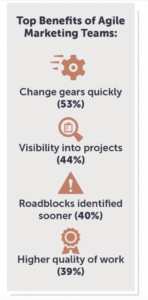
5 Reasons Your Enterprise Needs Agile Marketing
While startups may have an easier time adopting Agile principles, large enterprises can’t afford to be discouraged by the difficulty of introducing new processes into their organization. In fact, enterprises have an urgent need to tackle their process problems or risk disruption by emerging startup competitors. The good news is that leaders of marketing teams in established organizations are already paying attention to Agile marketing as a means to streamline their internal processes.
Twenty percent of respondents in this year’s annual State of Agile Marketing Report say they’re applying at least some Agile marketing practices in marketing teams of more than 70 people, and within organizations of over 5,000 members.

What does an enterprise stand to gain if it introduces Agile values, principles, and practices into its marketing department?
What about into the wider organization?
If you’re a company leader with a marketing team struggling to escape bad processes, Agile may be the key to your freedom.
Here’s what Agile can mean for an enterprise marketing group:
1. Noticeable Impact at Scale
Small, scrappy teams may have an easier time adopting Agile marketing methods. But, there are also natural limits to Agile’s progress in a startup environment.
Lack of resources, less simultaneous projects, and a natural ceiling to sharing knowledge in a tight-knit group means Agile can only go so far.
In an enterprise, adopting Agile may be more difficult and resource-heavy. However, the benefits have the potential to be more widely felt.

Enterprises have an opportunity to put greater resources behind their efforts and achieve greater impact, faster. In other words, if they support their Agile marketing efforts as powerfully as they’ve historically supported Big Bang campaigns the possibilities could be endless.
2. Faster Benefits to the Customer
Customers of established enterprises are also likely to feel the benefits of Agile marketing faster than customers of startups.
This is because customers of long-standing organizations already have a set of expectations regarding larger, more established companies.
When they begin reacting more quickly to change, producing higher quality work, and delivering more often (some of the key benefits of Agile marketing), the change is immediately obvious to their customers.
3. Innovation
Innovation has been a buzzword among organizational leaders for decades now, popularized by such catchy phrases as “innovate or die.”
This year’s State of Agile Marketing report queried 400+ marketers from startups and enterprises alike, and we found that 42% also had innovation on their minds and in their priorities.
In fact, “increasing innovation” was one of their top reasons for bringing Agile marketing into the organization in the first place.

In an increasingly competitive economy, established companies can’t rest on their laurels anymore.
Consistently increasing innovation can help enterprises attract the best talent, meet (and exceed) customer needs, stand out from their competitors, and grow at a healthy pace.
Although being Agile and being innovative are inherently different concepts, they are also intrinsically linked. The values and principles that come with adopting an Agile mindset result in encouraging innovative ideas to blossom and come to fruition among enterprise teams.
In a mature, self-organized Agile marketing team, the nurturing of a continuously improving process encourages all members to feel accountable for innovative ideas about the future.
Even in industries that appear to be stagnating, such as insurance, companies like ING in the Netherlands, have been promoting their use of Agile methods to bring more innovation into their business.
Faced with fast-moving disruptors, the connection between agility and survival is one they’re keenly aware of and actively exploring.
4. More Visibility
Building full process visibility into a team of ten or so people sounds daunting, but doable. Doing the same for a marketing team of more than a hundred members seems insurmountable.
This is one reason why the knee jerk solution is often to go straight to a massive reorganization.
The assumption is that existing structures need to be dismantled, which might be true, but jumping straight to the reorg often stymies Agile efforts before they really begin.
The daunting reorg is not a necessary first step towards agility, nor is it always necessary to achieving greater visibility across teams and projects.
There are many ways in which Agile encourages visibility without requiring the entire organization to turn on its head. Agile encourages visibility by:
- Introducing more feedback loops into the existing process
- Encouraging the visualization of work items and phases of progress
- Promoting more knowledge sharing for increased cross functionality
- Introducing a more collaborative process of prioritization
- Creating opportunities to bring together decision-makers (internal and external) with the team members who are closest to the work
Aiming for greater cross functionality and better communication between team members, and the teams they collaborate with, can go a long way.
Agile can offer steps towards eliminating the silos that naturally occur among teams and departments in a larger organization.
Even just the invitation to share feedback about “how things are done” can be a great motivator for better team performance.
Eventually, with more opportunities for visibility and better knowledge sharing about the goals of the organization, team members will feel more empowered to make decisions and lead, in addition to executing.
5. Faster Decision-Making
Most enterprises are facing an increasingly crowded market, regardless of how long they’ve been in business.
If they were once new kids on the block, their growing revenues and popularity over the years have made sure they’re now surrounded by competitors.
While enterprises may have bigger financial resources and more experience executing, their large sizes and hierarchies can make it difficult to have an efficient and effective process.
There’s a reason that startups refer to their enterprise competition as “bulky and slow.”
But if you’re an enterprise marketing leader, how do you change years (or maybe even decades) of established process patterns?
Adopting Agile principles, in marketing departments as well as across the wider organization, can help enterprises get a leg up on their competition, big or small.
During Agile trainings, we often discuss the difference between agile – meaning fast and nimble and Agile – a process methodology requiring a mindset shift.
Even though the two should not be used interchangeably, being Agile can often lead to faster delivery time and the ability to make more flexible, tactical pivots.
For example, even just adhering to the Agile principles of prioritizing the value of work completed, listening to your customers, and breaking down your work into more actionable tasks will already have many organizations on the fast track to further growth.
For large enterprises, being first and being fast is crucial…and unexpected.
Combining an enterprise’s abundant resources with a daily work process that is as agile as it is Agile can help large organizations compete on many fronts.
Bonus: Great PR
If what you’ve read so far has convinced you that Agile marketing makes total sense for an enterprise, you’ll also be glad to hear that if you choose to go the Agile route, you’ll be in good company.
In 2019, 31% of the marketers queried for the State of Agile Marketing Report stated that they come from companies of 1,000+ employees. 18% came from companies of 5,000+ employees.
The majority of these marketers are already practicing Agile marketing within their companies.

Smaller businesses and startups rarely have the resources (or the time) to chronicle their Agile marketing journeys. Luckily, a number of enterprises in a variety of sectors have published helpful case studies about theirs. As a result, these companies have been getting serious news coverage.
For example, the team at US software company CA Technologies has been particularly vocal about the wins and challenges during their organization-wide adoption of Agile using their company blog and Medium account.
Other technology giants, such as Mozilla, IBM and Dell, have also pursued implementations of Agile in their marketing departments.
Michelle Peluso, CMO of IBM, believes that “with the right budget and level of executive buy-in, you can turn a ship of any size towards great organizational agility.”
Even banks with an international presence, such as Santander, have begun to implement Agile marketing practices for their key campaigns. Running their promotional campaigns in an Agile way resulted in a 12% increase in their NPS (Net Promoter Score) – the highest in 17 years. Santander’s CMO, Keith Moor, goes into the tactical details of the marketing department’s transformation and their pilot approach in an article in MarketingWeek from 2017.
Check out some more examples of enterprises expanding the general knowledge base on Agile Marketing. These resources make it easier for companies of similar size, and new to Agile, to make use of existing know-how.
Size Doesn’t Matter, Agility Does
Thinking of becoming the Agile champion in your enterprise’s marketing team? Sometimes, taking the first step is all it takes to get your team rolling towards agility.
Let us know in the comments below if you’re on an Agile marketing journey within your enterprise team or if you’d like to be!
The post 5 Reasons Your Enterprise Needs Agile Marketing appeared first on AgileSherpas.com.






